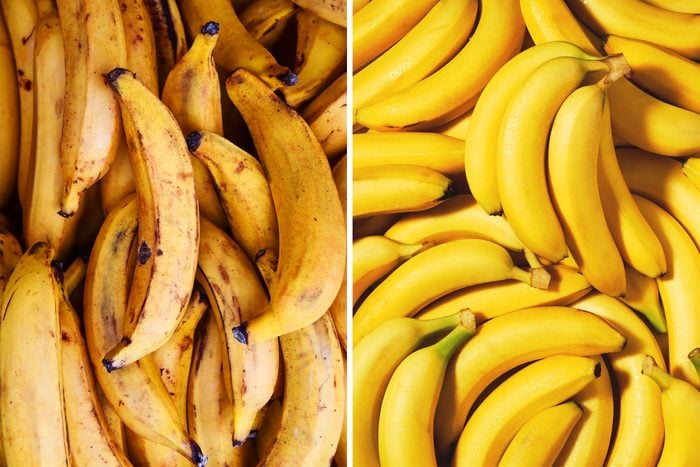Plantains vs. Bananas: What’s the Difference?
Updated: Feb. 13, 2024

Curious about plantains, the banana look-alikes in grocery stores? Here's a guide to the differences between plantains vs. bananas, including the most delicious ways to eat both fruits.
If you’re in a hurry at the grocery store, you might accidentally pick up a bunch of bananas that feel surprisingly heavy—only to notice that they’re labeled plantains.
Like other commonly confused foods, bananas and plantains look very similar, but as soon as you peel back the skin, you’ll find a big difference! Both fruits are delicious, but they’re definitely not interchangeable. Here’s what to know about bananas vs. plantains.
The Differences Between Plantains vs. Bananas
Bananas and plantains look similar and are part of the same fruit family, however they differ a bit in their appearance, flavor, texture and culinary use.
Bananas are usually smaller than plantains, with thinner skin and softer, sweeter flesh. Plantains are bigger, with thicker skin and starchier fruit.
Oh, check here whether or not can you eat green bananas.
Both these fruits ripen from green to yellow to brown, and they are edible at every stage. However, green bananas can be bitter.
Where They’re Grown
Most fruits in the banana family grow best in humid, tropical regions. Both bananas and plantains are indigenous to the tropical regions of Southeast Asia, from which they traveled via trade routes to Africa, and then to the Caribbean, where they became a staple in the cuisine.
Today, hundreds of banana varieties grow all around the world, from South America to Asia. Most bananas bought in the US are Cavendish, and come from tropical regions in Central and South America, including Honduras, Panama, Costa Rica, Guatemala, Ecuador, Colombia, Nicaragua, Mexico and Peru. Bananas can also grow in tropical regions of the US, such as Florida and Hawaii.
Taste
Cavendish bananas are tasty eaten raw, though they’re also delicious in baked goods, especially desserts. Their creamy smoothness and natural sweetness makes them an excellent addition to smoothies or fruit salads. You can even cook bananas, throwing them in a saute pan or onto the grill to bring out a caramelized sweetness.
Plantains have a higher starch content than bananas, so they aren’t quite as sweet, especially if eaten when still green. The less soft, slightly tough plantain fruit is best eaten cooked: sauteed, fried, baked or even boiled! In many cuisines, plantains are about as likely to feature in savory dishes, like this vegetable-plantain mash, as in desserts. Plantains are commonly enjoyed in Caribbean, African and South American cuisines. Favorite dishes include deep-fried tostones, ropa vieja and Patacon Maracucho, a delicious sandwich.
Nutrition
Bananas and plantains have very similar nutrition profiles. Both are good sources of several vitamins, including potassium, magnesium and vitamin C. They’re also good sources of fiber. Bananas do have more sugar, though, and plantains have more starch.
The relative nutrition of bananas vs. plantains might depend on how you eat them. Fried, sugar-dusted plantains will obviously be less healthy than a ripe banana eaten raw from the peel.
Those new to eating plantains should start with ripe plantains, which are easier to slice. Try a crowd-pleasing dish of air-fried plantains, served alongside a summer cookout or a cozy winter stew—you won’t be disappointed!
